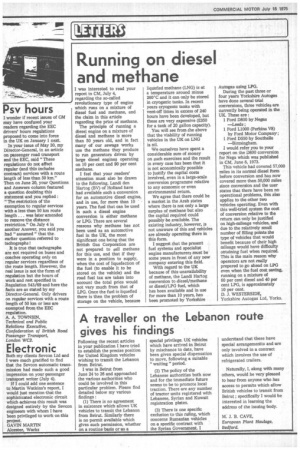Running on diesel and methane
Page 30

If you've noticed an error in this article please click here to report it so we can fix it.
I was interested to read your report in CM, July 4, regarding the so-called ".° revolutionary type of engine which runs on a mixture of diesel fuel and methane, and the claim in this article regarding the price of methane.
The principle of running a diesel engine on a mixture of diesel and methane is more than 50 years old, and in fact many of our sewage works use the methane they produce to run generators driven by large diesel engines operating on 10 per cent and 90 per cent methane.
I feel that your readers' attention muat also be drawn to the following. Laridi den Hartog (BV) of Holland have had available such a conversion for an automotive diesel engine, and in use, for more than 10 years. The fuel that can be used in such a diesel engine conversion is either methane or LPG. There are several reasons why methane has not been used as an automotive fuel in the UK, the most significant one being that the British Gas Corporation are not prepared to sell methane for this use, and that if they were in a position to supply, when the cost of liquefaction of the fuel (to enable it to be stored on the vehicle) and the road fuel tax are taken into account the total price would not vary much from that of LPG. Once the fuel is liquefied . there is then the problem of storage on the vehicle, because liquefied methane (LNG) is at a temperature around minus 260°C and it can only be stored in cryogenic tanks. In recent years cryogenic tanks with vent-off times in excess of 240 hours have been developed, but these are very expensive (£350 for a tank of 20 gallon capacity).
You will see from the above that the viability of running vehicles in the UK on LNG is nil.
We ourselves have spent a considerable sum of money on such exercises and the result in every case has been that it is not economically possible to justify the capital costs involved, even in a large-scale conversion programme relative to any economic or even environmental return.
We agree that there could he a market in the Arab states where there is not only a large surplus of methane but also the capital required could possibly be available. The existing industry, however, is not unaware of this and vehicles are already operating there in this form. , I .suggest that the present fuel systems and specialist engine manufacturers must be some years in front of any new company entering this field.
With regard to the UK because of this unavailability of methane, the Landi Hattog conversion to diesel/methane or diesel/LPG fuel, which has been available and in use for more than 10 years, has been promoted by Yorkshire Autoges using LPG.
During the past three or four years Yorkshire Au/togas have done several trial conversions, three vehicles are currently being operated in the UK. These are : 1 Ford D800 by Negas —Leeds ; 1 Ford L1000 (Perkins V8) by Ford Motor Company ; 1 Ford D550 by Soathalla —Birmingham.
I would refer you to your . report on the D800 conversion for Nega which was published in CM, June 8, 1973.
This vehicle had covered 57,000 miles in its normal diesel form .before conversion and has now covered more than 50,000 miles since converainn and the user states that there have been no operational problems, this also applies to the other two vehicles operating. Even With this well-tried system the cost of conversion relative to the return can only be juatified on high-mileage vehicles, and due to the relatively small number of filling wants the type of vehicles that would benefit because of their high mileage would have difficulty ontainin,g fuel when required. This is the main reason why operators are not really prepared to go ahead on LPG even when the fuel coat saving, running on a mixture of 60 per cent diesel and 40 per cent LPG, is approximately 10 per tent.
D. J. WESTERSIDE, Yorkshire Autogas Ltd, Yorks.




























































































